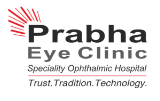Neuro Ophthalmologists at Prabha Eye Clinic treat patients who have reduced vision, blind spot owing to disorders of the optic nerve and its connections to the brain leading to subnormal vision or field loss. Many conditions which can be life threatening can be diagnosed by eye examination by neuro ophthalmologist.
Neuro Ophthalmology Specialists:
- Dr. Krishna R Murthy
- Dr. Geethanjali CJ
- Dr. Ajinkya V Deshmukh
They also evaluate and treat any condition in which there may be a brain abnormality causing a disturbance of vision, misalignment of the eyes, or abnormal eye movements.
Our specialists also provide evaluation of focal dystonia, blepharospasm and hemi facial spasm, as well as botulinum toxin treatments for these conditions.
Optic Neuritis
Optic neuritis is an inflammation of the optic nerve. The optic nerve allows you to see by carrying images from your retina to your brain. The optic nerve resembles that of electrical wires or nerve fibers. Each wire carries a part of the visual information to the brain. If some or all of the nerve fibers become inflamed and do not function properly, vision becomes blurred. With optic neuritis, the optic nerve becomes swollen and the nerve fibers do not work properly. Vision can range from near normal to very poor depending on the number of inflamed nerve fibers.
Symptoms
- Blurred vision in one or both eyes (especially after exercising or taking a hot bath).
- Dim vision (as if the lights were turned down).
- Abnormal color vision (dull and faded colors).
- Pain behind the eye, particularly when moving the eyes.
The symptoms described above may not necessarily mean that you have optic neuritis. However, if you experience one or more of these symptoms, contact your eye doctor for a complete exam.
Treatment
Optic neuritis usually occurs suddenly. If you experience any of the symptoms listed above, call your ophthalmologist. By looking in the back of your eye with an instrument called the ophthalmoscope, ophthalmologist can see any optic nerve swelling. Optic neuritis may be confused with other causes of poor vision. Other tests such as color vision, side vision, and the reaction of the pupil to light may be performed. Ultrasound or magnetic scanning or visual brainwave recordings may be needed.
Optic Atrophy
Optic Atrophy means the loss of some or most of the nerve fibers in the optic nerve. (Resulting in severe visual loss). Many diseases and disorders can lead to optic atrophy or damage to one or both optic nerves. Optic atrophy can occur in people where the optic nerve or nerves did not develop properly. It may also result from inflammation of the optic nerve or from glaucoma when the pressure inside the eye remains too high. In unusual cases, poisons, vitamin deficiencies, or tumors may be responsible. Most commonly, optic atrophy simply occurs without a known or proven cause.
Symptoms
- Blurred vision.
- Abnormal side vision.
- Abnormal color vision.
- Poor constriction of the pupil in light
- Decreased brightness in one eye relative to the other.
The symptoms described above may not necessarily mean that you have optic neuritis / optic neuropathy. However, if you experience one or more of these symptoms, contact your eye doctor for a complete exam.
Treatment
The optic nerve enters the back of the eye where it appears as a small disc, which your ophthalmologist can examine by looking through the pupil of your eye with a special instrument called an ophthalmoscope. If optic atrophy is present, this small disc will appear pale or white, indicating loss of nerve fibers. If you show some of the symptoms listed above, your ophthalmologist may decide to perform additional tests. Unfortunately, there is no effective treatment for optic atrophy. Once the nerve fibers in the optic nerve are lost they never heal or grow back. Therefore, the best defence is an early diagnosis because if the cause can be found and corrected, further damage can be prevented.
Cranial nerve Palsies
Cranial nerve palsies of ophthalmic importance present most commonly with double vision when both eyes are open, drooping of eyelids, unable to close the eyelids completely and blurring of vision. A thorough clinical assessment followed by a neuroimaging would be necessary to localise the site and cause of lesion. The double vision may be treated with patching, frosted glasses and or Botox injection. A neurologist or a neurosurgeon referral will be necessary for further management in certain cases.
Migraine and other types of headache: Our neuro-ophthalmologists are trained in diagnosing and treating various types of headaches in children and in adults. A detailed history is taken and appropriate investigations are advised to know the root cause for headache and is treated in association with neurologists.






